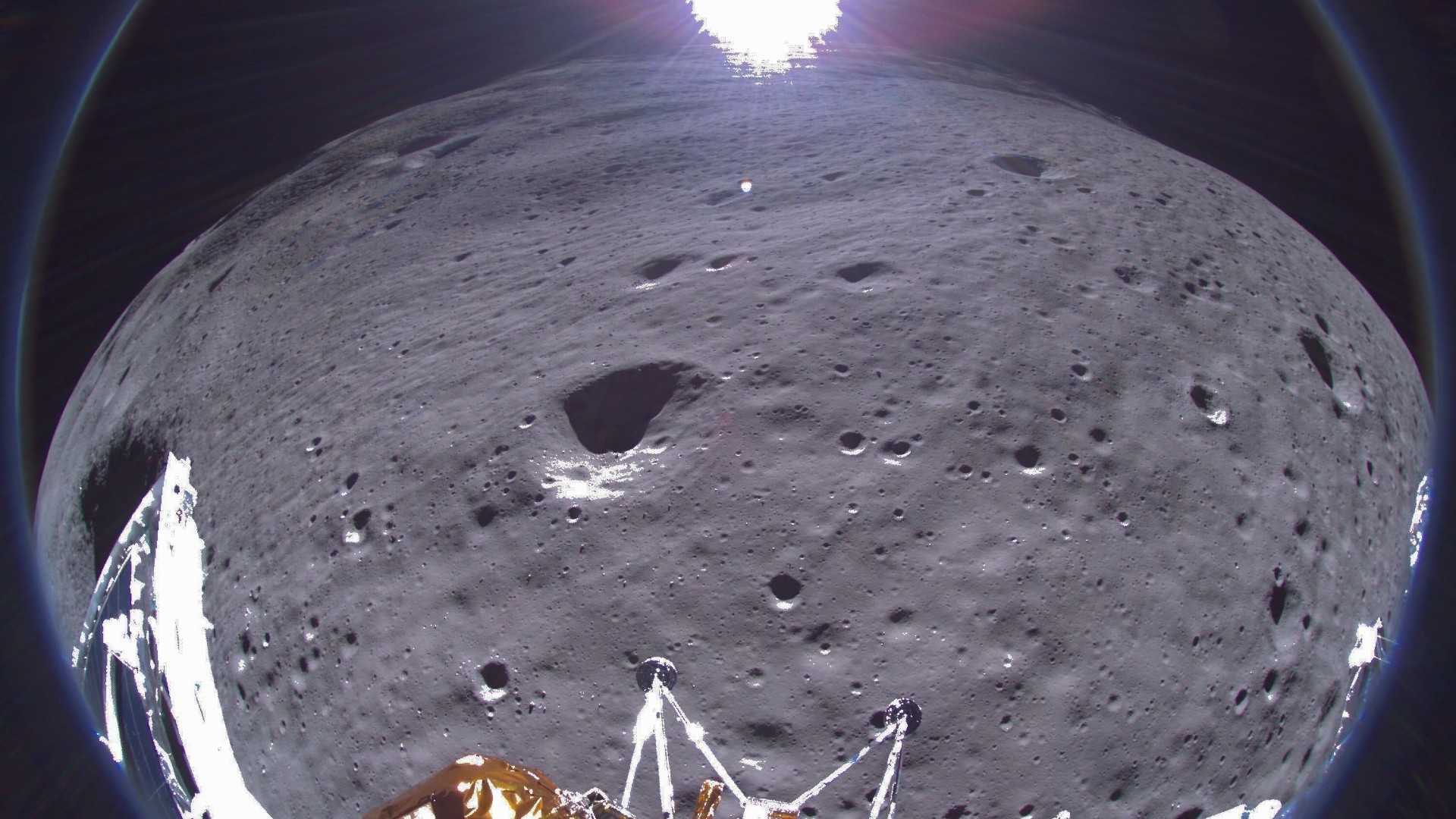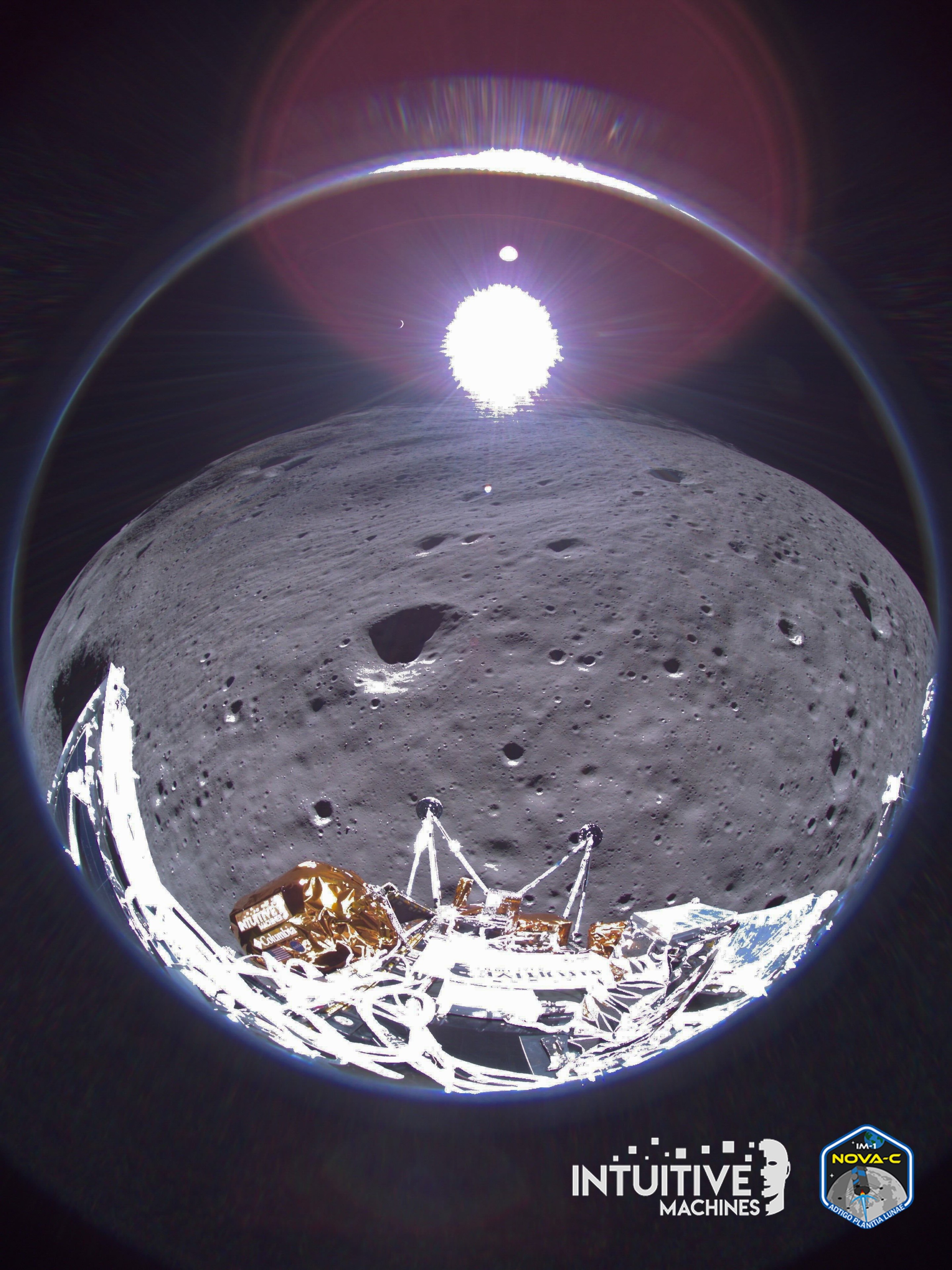
A history-making private lander has closed its eyes on the moon — but perhaps not forever.
Houston-based company Intuitive Machines shut down its robotic Odysseus spacecraft on Thursday (Feb. 29) ahead of the onset of a long, cold lunar night. Seven days earlier, the solar-powered lander became the first-ever private spacecraft to touch down softly on the moon, and the first U.S. vehicle to do so since Apollo 17 achieved the feat in 1972.
This shutdown, however, could end up being just a nap for the lander, which the mission team affectionately calls Odie.
"I think what we're going to do is kind of tuck Odie in for the cold night of the moon and see if we can't wake him up here when we get a solar noon here in about three weeks," Intuitive Machines co-founder and CEO Steve Altemus said during a press conference on Wednesday afternoon (Feb. 28).
The company reiterated that hope in a post on X on Thursday that also shared a new selfie of the lander. "Goodnight, Odie. We hope to hear from you again," the post reads, in part.
Related: Private Odysseus moon lander broke a leg during historic touchdown (new photos)
Odysseus launched Feb. 15 atop a SpaceX Falcon 9 rocket, headed for the moon and a date with destiny.
The 14.1-foot-tall (4.3 meters) spacecraft reached lunar orbit on Feb. 21 and touched down a day later near Malapert A, a crater about 190 miles (300 kilometers) from the moon's south pole. The landing was a success, but it wasn't easy.
Just hours before touchdown, the mission team discovered that Odysseus' laser rangefinders, which were supposed to give the craft its altitude and horizontal-velocity readouts during the descent, weren't functioning. So, they devised a workaround, pressing into service an experimental LIDAR (light detection and ranging) instrument that NASA put on board the lander.

This technology demonstration was one of six payloads the agency flew on Odysseus via a $118 million contract awarded by its Commercial Lunar Payload Services (CLPS) program. CLPS is leveraging the emerging capabilities of American private landers to send NASA science gear to the moon. The main goal is to aid the agency's Artemis program, which aims to set up a base near the lunar south pole by the end of the 2020s.
Odysseus also carried six private payloads on this debut mission, which Intuitive Machines calls IM-1. Among those was a sample of Columbia Sportswear's "Omni-Heat Infinity" insulative material, which got a deep-space test on the flight, and an archive that will preserve on the moon a large sample of humanity's accumulated knowledge, including the secrets behind David Copperfield's most famous illusions.
Another private payload was EagleCam, a camera system built by students at Embry-Riddle Aeronautical University. EagleCam was supposed to deploy from Odysseus during the Feb. 22 descent in order to snap photos of the action from ground level. The mission team decided to keep EagleCam on board during the landing, however, due to the navigation issues. EagleCam was finally deployed on Wednesday, but it wasn't able to send imagery home before Odie went dark.
Navigation issues also contributed to Odysseus' relatively rough touchdown. The lander came in a bit faster than planned on Feb. 22. It hit the sloping lunar ground relatively hard, breaking one or two of its six legs and eventually tipping over onto its side.
This orientation made it harder for the mission team to communicate with Odysseus, and harder for the lander to harvest the sunlight it needed to keep operating in the harsh lunar environment. Still, Odie managed to hit its longevity mark: Intuitive Machines had previously estimated Odysseus' surface mission would last a week or so.

Despite the above issues, Intuitive Machines and NASA both regard Odysseus' moon landing as a success, one that bodes well for the future of lunar exploration. The space agency, for example, got data down from all five of its active instruments on Odie. (The sixth is a laser retroreflector array, a passive instrument designed to help other lunar spacecraft navigate.)
"The bottom line is that every payload has met some level of their objective, and we're very excited about that," Sue Lederer, CLPS project scientist at NASA's Johnson Space Center in Houston, said during Wednesday's press briefing.
Lederer also voiced optimism about Odie's chances of waking up from its long lunar sleep, even though the probe wasn't designed to do so.
"He's a scrappy little dude," she said. "So, I have confidence in Odie at this point. It's been incredible."
And there is precedent for such a revival: Japan's SLIM spacecraft, the nation's first-ever successful moon lander, woke up from its lunar hibernation just a few days ago.
So, keep your fingers crossed: We may yet hear from Odie again.







